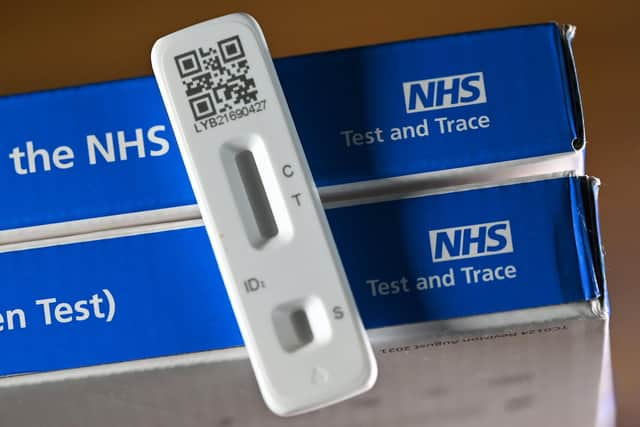Covid-19 symptoms: What are the 9 new symptoms added by the NHS, why has the list been extended, what to do if you have these symptoms, are they similar to a cold, has free testing ended and what are the new isolation rules?
and live on Freeview channel 276
There are now nine new ailments to look out for, added to the website on Friday afternoon.
This new information comes as the government scrapped free universal lateral flow tests over the weekend.
Covid infections have been rising rapidly.
Advertisement
Hide AdAdvertisement
Hide AdOn Friday, the Office for National Statistics (ONS) said an estimated one in 13 people in England were infected.
This is from the week ending on March 26, and the figure does not include people living in hospitals, care homes, or other communal establishments.
In the UK, roughly 4.9 million had Covid-19 that week, rising from 4.3 million the week before.


Here is everything you need to know:
What are the new symptoms?
The new symptoms are listed on the NHS website.
These include shortness of breath, feeling tired or exhausted, an aching body, a headache, a sore throat, a blocked or runny nose, loss of appetite, diarrhoea, and feeling or being sick.
Advertisement
Hide AdAdvertisement
Hide AdThe NHS also includes a loss or change to your sense of taste and smell, a new continuous cough – three or more episodes in a day – and a high temperature.
Shivering is also listed next to a high temperature – where you feel hot to touch on your chest or back.
Are these new symptoms like a cold?
The NHS considers the new ailments to be consistent to similar illnesses.
A statement on its website said: ‘The symptoms are very similar to symptoms of other illnesses, such as colds and flu.’
Advertisement
Hide AdAdvertisement
Hide AdThere has been criticism towards the government over not including more official symptoms sooner.
The World Health Organisation and the Centres for Disease Control and Prevention, in the USA, have had more extensive lists for some time.
Why have more symptoms been added?
Medical professionals have been putting pressure on the government to include a greater array of symptoms.
It is understood the Government’s chief medical officer would have needed to sign off the expanded list.
The aim is to help reduce Covid infections.
Advertisement
Hide AdAdvertisement
Hide AdIf more people are aware of a greater array of symptoms, they are more likely to know if they have the disease and self isolate.
What to do if you have these symptoms?
It is advised to limit social contact as much as possible if you have these symptoms.
The recommendations on the NHS website are: ‘Try to stay at home and avoid contact with other people if you have symptoms of COVID-19 and either: you have a high temperature, or you do not feel well enough to go to work or do your normal activities.’
Limiting interaction with those who are clinically vulnerable is also suggested.
Advertisement
Hide AdAdvertisement
Hide AdPeople are advised to go back to their normal activities when their symptoms have subsided.
More information on what to do if you are clinically vulnerable can be found here.
What are the new isolation rules?
It is not compulsory to self isolate if you have Covid-19.
The legal requirement was lifted on February 24, as part of the government’s ‘living with Covid’ plan.
Currently, the government guidance is to avoid close contact with other people if you go outside, and stay at home if you feel too unwell.
Advertisement
Hide AdAdvertisement
Hide AdPeople are also advised to work from home if they can, and to talk to their employer is this is not possible.
Methods such as asking people to get food and essentials for you, while you have the ailments, should also be considered.
Other actions aimed at reducing the spread of Covid-19 include wearing a face mask, not using public transport, not going to large gatherings, covering your mouth and nose when you sneeze, and washing your hands frequently, is recommended.
Has free Covid testing ended?
The new list coincides with the government scrapping free universal Covid testing.
Advertisement
Hide AdAdvertisement
Hide AdIt is no longer mandatory to take a test if you have symptoms.
In England, some people still qualify for free tests in certain circumstances, but the majority will have to buy lateral flows from pharmacies or other retailors.
NHS front line, social care employees, and citizens with specific health conditions are among those who can get free tests.
A full list of those who qualify can be found on the NHS website here.
Advertisement
Hide AdAdvertisement
Hide AdPreviously, people could only qualify for a PCR test if they had one of the three original symptoms, or had been invited to take a test.
The NHS recommend calling the 111 non-emergency number if you are worried about your ailments.
A message from the Editor, Mark Waldron
Subscribe here for unlimited access to all our coverage, including Pompey, for just 26p a day.
Comment Guidelines
National World encourages reader discussion on our stories. User feedback, insights and back-and-forth exchanges add a rich layer of context to reporting. Please review our Community Guidelines before commenting.
